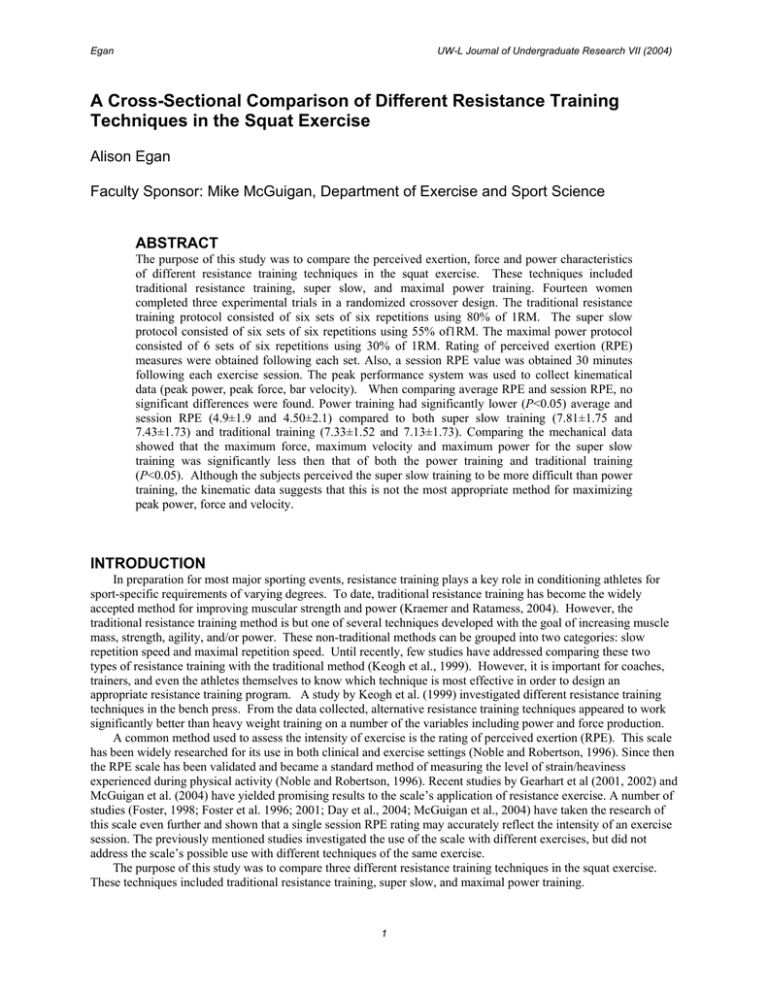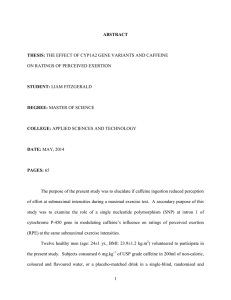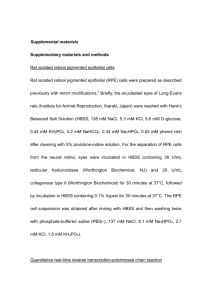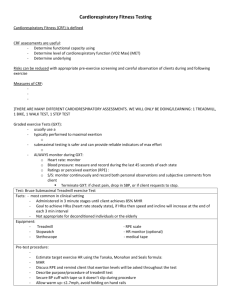A Cross-Sectional Comparison of Different Resistance Training Alison Egan
advertisement

Egan UW-L Journal of Undergraduate Research VII (2004) A Cross-Sectional Comparison of Different Resistance Training Techniques in the Squat Exercise Alison Egan Faculty Sponsor: Mike McGuigan, Department of Exercise and Sport Science ABSTRACT The purpose of this study was to compare the perceived exertion, force and power characteristics of different resistance training techniques in the squat exercise. These techniques included traditional resistance training, super slow, and maximal power training. Fourteen women completed three experimental trials in a randomized crossover design. The traditional resistance training protocol consisted of six sets of six repetitions using 80% of 1RM. The super slow protocol consisted of six sets of six repetitions using 55% of1RM. The maximal power protocol consisted of 6 sets of six repetitions using 30% of 1RM. Rating of perceived exertion (RPE) measures were obtained following each set. Also, a session RPE value was obtained 30 minutes following each exercise session. The peak performance system was used to collect kinematical data (peak power, peak force, bar velocity). When comparing average RPE and session RPE, no significant differences were found. Power training had significantly lower (P<0.05) average and session RPE (4.9±1.9 and 4.50±2.1) compared to both super slow training (7.81±1.75 and 7.43±1.73) and traditional training (7.33±1.52 and 7.13±1.73). Comparing the mechanical data showed that the maximum force, maximum velocity and maximum power for the super slow training was significantly less then that of both the power training and traditional training (P<0.05). Although the subjects perceived the super slow training to be more difficult than power training, the kinematic data suggests that this is not the most appropriate method for maximizing peak power, force and velocity. INTRODUCTION In preparation for most major sporting events, resistance training plays a key role in conditioning athletes for sport-specific requirements of varying degrees. To date, traditional resistance training has become the widely accepted method for improving muscular strength and power (Kraemer and Ratamess, 2004). However, the traditional resistance training method is but one of several techniques developed with the goal of increasing muscle mass, strength, agility, and/or power. These non-traditional methods can be grouped into two categories: slow repetition speed and maximal repetition speed. Until recently, few studies have addressed comparing these two types of resistance training with the traditional method (Keogh et al., 1999). However, it is important for coaches, trainers, and even the athletes themselves to know which technique is most effective in order to design an appropriate resistance training program. A study by Keogh et al. (1999) investigated different resistance training techniques in the bench press. From the data collected, alternative resistance training techniques appeared to work significantly better than heavy weight training on a number of the variables including power and force production. A common method used to assess the intensity of exercise is the rating of perceived exertion (RPE). This scale has been widely researched for its use in both clinical and exercise settings (Noble and Robertson, 1996). Since then the RPE scale has been validated and became a standard method of measuring the level of strain/heaviness experienced during physical activity (Noble and Robertson, 1996). Recent studies by Gearhart et al (2001, 2002) and McGuigan et al. (2004) have yielded promising results to the scale’s application of resistance exercise. A number of studies (Foster, 1998; Foster et al. 1996; 2001; Day et al., 2004; McGuigan et al., 2004) have taken the research of this scale even further and shown that a single session RPE rating may accurately reflect the intensity of an exercise session. The previously mentioned studies investigated the use of the scale with different exercises, but did not address the scale’s possible use with different techniques of the same exercise. The purpose of this study was to compare three different resistance training techniques in the squat exercise. These techniques included traditional resistance training, super slow, and maximal power training. 1 Egan UW-L Journal of Undergraduate Research VII (2004) METHODS Experimental Approach to the Problem This study used a randomized crossover design in which subjects completed three experimental trials. The trials were performed in a randomized order. Subjects were tested at the same time of day during each of the experimental trials with no less then 48 hours between trials. For the purpose of safety and the elimination of possible external variables, which potentially could have affected results, all testing was performed on a Smith Machine. The Peak Performance System, which allows kinematical data to be collected (including measurement of power and force variables, peak power, peak force, bar velocity and displacement) was used. Video analysis was performed to assess the body segment positions during the different exercise techniques. The testing schedule consisted of one familiarization session where subjects signed an informed consent form, performed a one repetition maximum (1RM) test, practiced the three types of training including traditional, super slow and jump squats, and had their height and weight measured. The subsequent session order was randomized for each subject and included one session of heavy resistance training, one session of super slow training, and one session of explosive resistance training. Subjects Fourteen well-trained women between the ages of 18 and 24 were recruited for this study. The subjects were free from any skeletal, muscle, cardiovascular, or endocrine limitations and were currently involved in a resistancetraining program (of at least two sessions per week) for a minimum of 3 months. The subjects were required to sign a written informed consent form as per the university’s Institutional Review Board’s approval. All subjects received a standardized physical examination of height, and body mass during the first phase of the study. During the duration of the study, subjects were be told to refrain from exercise 48 hours prior to each testing session, to follow the same diet on each day of each trial, and not to eat for at least 3-4 hours prior to any given testing session. In addition, subjects were instructed to abstain from alcohol, caffeine, and nicotine for a minimum of 24 hours prior to any testing session. Testing Procedures Each subject was familiarized with the different training techniques during the familiarization session. 1RM testing was also conducted at this time using previously described methods (McGuigan et al., 2004). The super slow method used 55% of 1RM with 10 seconds for the eccentric and 10 seconds for the concentric phase while attempting to maintain constant velocity. A metronome was used to aid the subject in maintaining the correct tempo. The maximal power training used 30% of 1RM. For the power method, subjects performed an explosive jump squat. The traditional method used 80% of 1RM. All resistance training techniques was assessed using six sets of 6 repetitions. All testing was conducted using the smith machine and the Peak Performance Measurement system (Peak Performance Technologies, Centennial, CO). The system allowed kinematic data to be collected including measurement of peak power, peak force, bar velocity and displacement. Vertical force was recorded on a Kistler force plate (Winterthur, Switzerland). Force data was sampled at a rate of 1000 Hz. Video analysis was also performed to assess the bar displacement during the different exercise techniques. Although the data were recorded for all repetitions of all tests, the highest value for peak power, peak force and bar velocity were used for analysis. Rating of Perceived Exertion Measures During the familiarization session, each subject was given instructions on the use of the RPE scale. RPE measures were taken after completion of each set. The session RPE measure was used to rate the entire workout (Figure 1). The subject was shown the scale 30 minutes following conclusion of the training bout and asked, “How was your workout?” 2 Egan UW-L Journal of Undergraduate Research VII (2004) Figure 1. RPE Scale. Following each trial the subject was shown this scale and asked “How would you rate your effort?” Thirty minutes post workout subjects were again shown the scale and asked, “How would you rate your entire workout?” Statistical Analysis Statistical significance was set at P<0.05. Comparisons among the groups were made using one-way analysis of variance. The Turkey post-hoc test was used to identify significant differences in group means. RESULTS Subject Characteristics The groups means (± SD) for age, height, weight, squat 1RM and squat to bodyweight ratio were 22 ± 3 yrs, 168 ± 7 cm, 65 ± 17 kg, 58 ± 16 kg and 0.85 ± 0.24. RPE When comparing average RPE and session RPE no significant difference was seen (Figure 2). Power training had significantly lower average and session RPE (4.9 ± 1.9 and 4.50 ± 2.1) compared to both super slow training(7.81 ± 1.75 and 7.43 ± 1.73) and traditional training (7.33±1.52 and 7.13±1.73). Figure 2. Average and Session RPE values (Mean ± SD) for traditional, maximal power and super slow training sessions. * indicates that the maximal power RPE was significantly less compared to traditional and super slow. 3 Egan UW-L Journal of Undergraduate Research VII (2004) Performance Variables Comparing the mechanical data showed that the maximum force, maximum velocity and maximum power for the super slow training was significantly less then that of both the power training and traditional training (Table 1). Table 1. Biomechanical Data Traditional Maximal Power Super Slow Force (N) 1294.92 ⊥ 534.84 1425.81 + 618.18 960.00 ± 465.68 Velocity (m/a) 1.70 ⊥ 0.51 2.75 – 0.71 1.46 ± 0.56 Power (W) 1777.88 — 590.29 2003.39 + 879.35 811.79 ± 313.93 DISCUSSION The purpose of this study was to compare three different resistance training techniques in the squat exercise. The super slow and traditional resistance training methods were perceived as being significantly harder than the maximal power method. There was no significant difference between the mean RPE measures taken following each set and the session RPE for each training method. However, the biomechanical data showed that the subjects perceived the super slow method with the lowest force, power, and velocity to be more physically difficult then the maximal power and traditional methods with the highest force, power, and velocity. A previous study by Keogh et al. (1999), which served as a model for this study, used similar loading. The bench press exercise was used in that study whereas we chose to use to examine the squat exercise. Keogh et al. (1999) showed that the super slow method and maximal power method recorded significantly lower levels of force and integrated electromyography than traditional resistance training. However, maximal power resulted in greater levels of power production. For the squat exercise, we also showed that the maximal power results in the greatest peak power output (Table 1). Since training at higher power outputs appears to significantly increase muscular power (Kraemer and Ratamess, 2004), using maximal power training would appear to be the optimal method for improving maximum muscular power. The results showed that the super slow method resulted in significantly lower force, power and velocity than the other methods. This suggests that this method would be inappropriate for increasing most aspects of muscular function. This is despite the fact that super slow was perceived as being more difficult than maximal power training. It is possible that the increased time under tension that occurs with super slow training may make it a useful stimulus for training for hypertrophy or muscular endurance. However, there are no training studies that have been performed that have shown this method to have any additional advantage over traditional training methods (Kraemer and Ratamess, 2004). There appears to be no evidence to support the use of super slow training in the enhancement of strength and power. It would seem that super slow training would not be specific to the needs of athletes in particular. The RPE values for each set were taken in addition to the session rating. The purpose of taking the RPE values following each set was to further familiarize the subjects with rating their perceived effort on the RPE scale. We believed this would increase the accuracy of the session RPE value. The lack of significant difference between the RPE measures and the session RPE confirm findings from previous studies in our laboratory (Day et al., 2004; McGuigan et al., 2004). This further highlights the potential application of the session RPE method for monitoring the intensity of resistance training. Taking a single measure following a training session appears to be much easier than using multiple measures of RPE throughout a resistance training workout. The session RPE seems to be an easy and effective method to prescribe work intensities. The data from this study showed that there are significant differences in both the perceived exertion and the response of acute biomechanical variables when using different methods of resistance exercise. Although the subjects perceived the super slow training to be more difficult than power training, the kinematic data suggests that this is not the most appropriate method for maximizing peak power, force and velocity. The study also confirmed the usefulness of the session RPE method for monitoring the intensity of resistance training sessions. 4 Egan UW-L Journal of Undergraduate Research VII (2004) ACKNOWLEDGEMENTS The author wishes to thank Jason Winchester and Jeremiah Lurken for their assistance with the study and the Undergraduate Research Committee for their financial support REFERENCES DAY, M.L., M.R. MCGUIGAN, G.A. BRICE, AND C. FOSTER. (2004). Monitoring exercise intensities during resistance training using a session RPE scale. Journal of Strength and Conditioning Research. 18: 353-358. FOSTER, C., J.A. FLORHAUG, J. FRANKLIN, L. GOTTSCHALL, L. HROVATIN, S. PARKER, P. DOLESHAL, AND C. DODGE. (2001) A new approach to monitoring exercise testing. Journal of Strength and Conditioning Research. 15: 109-115. FOSTER, C. (1998) Monitoring training in athletes with reference to overtraining syndrome. Medicine and Science and Sports and Exercise. 30, 1164-1168. GEARHART, JR. R.F., F.L. GOSS, K.M. LAGALLY, J.M. JAKICIC, J. GALLAGHER, K.I. GALLAGHER, AND R.J. ROBERTSON. (2002) Ratings of perceived exertion in active muscle during high-intensity and lowintensity resistance exercise. Journal of Strength and Conditioning Research. 16: 87-91. GEARHART, JR. R.F., F.L. GOSS, K.M. LAGALLY, J.M. JAKICIC, J. GALLAGHER, AND R.J. ROBERTSON. (2001) Standardized scaling procedures for rating of perceived exertion during resistance exercise. Journal of Strength and Conditioning Research. 15: 320-325. KEOGH, J.W.L., G.J. WILSON, AND R.P. WEATHERBY. (1999) A Cross-Sectional Comparison of Different Resistance Training Techniques in the Bench Press. Journal of Strength and Conditioning Research. 13: 247-258. KRAEMER, W.J., AND N.A. RATAMESS. (2004) Fundamentals of resistance training: Progression and exercise prescription. Medicine and Science in Sports and Exercise. 36: 674-688 MCGUIGAN, M.R., A. EGAN, AND C. FOSTER. (2004) Salivary cortisol responses and perceived exertion during high intensity and low intensity bouts of resistance exercise. Journal of Sports Science and Medicine. 3, 815 NOBLE, B.J., AND R.J. ROBERTSON. (1996) Perceived Exertion. Champaign, IL: Human Kinetics. 5




